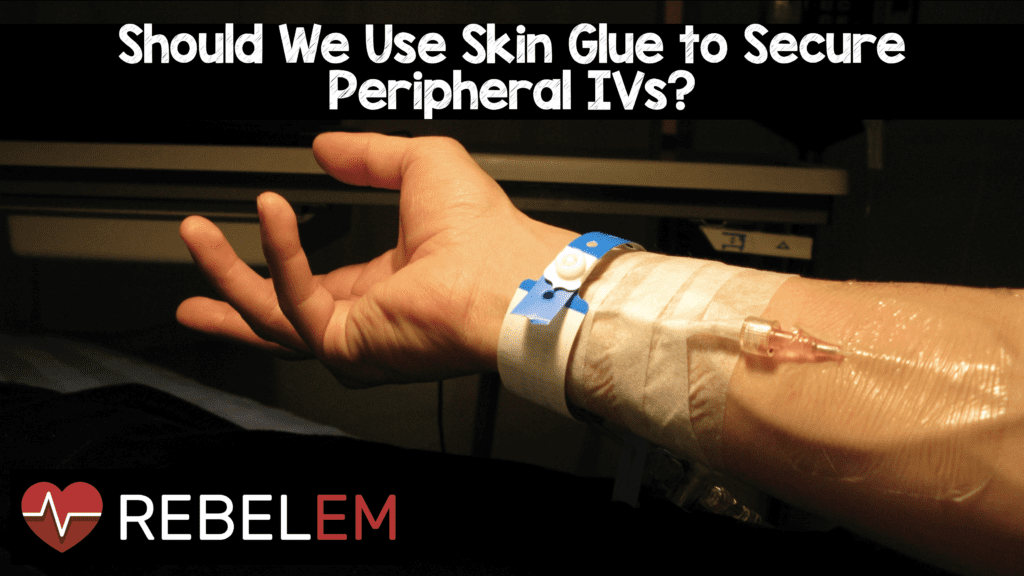
 Background: Peripheral venous cannulation is the most frequently performed procedure in the Emergency Department (ED). The vast majority of patients admitted to the hospital will leave the ED with an intravenous catheter (IV). While these devices typically have a “life-span” of 72 hours from placement, they often fail prematurely as a result of infection, phlebitis, occlusion or dislodgement. IV dislodgement is a particular bane to emergency providers and nurses because it often occurs during the patient’s ED stay requiring repeated cannulation and the associated expenditure of time and resources not to mention the additional pain/discomfort to the patient. Inadequate fixation of the catheter is a likely cause of dislodgement but may also contribute to infection and phlebitis due to small movements leading to microtrauma to the vein.
Background: Peripheral venous cannulation is the most frequently performed procedure in the Emergency Department (ED). The vast majority of patients admitted to the hospital will leave the ED with an intravenous catheter (IV). While these devices typically have a “life-span” of 72 hours from placement, they often fail prematurely as a result of infection, phlebitis, occlusion or dislodgement. IV dislodgement is a particular bane to emergency providers and nurses because it often occurs during the patient’s ED stay requiring repeated cannulation and the associated expenditure of time and resources not to mention the additional pain/discomfort to the patient. Inadequate fixation of the catheter is a likely cause of dislodgement but may also contribute to infection and phlebitis due to small movements leading to microtrauma to the vein.
Medical-grade skin glue (cyanoacrylate) has been demonstrated to reduce peripheral arterial line failure rate in prior studies but has not been extensively studied for peripheral IV securing.
What Article are We Discussing Today?
Budgen S et al. Skin glue reduces the failure rate of emergency department-inserted peripheral intravenous catheters: a randomized controlled trial. Ann Emerg Med 2016. PMID: 26747220
Clinical Question: Does the use of cyanoacrylate skin glue with a polyurethane dressing to secure peripheral IVs decrease overall failure rate in comparison to standard securing with a polyurethane dressing alone?
Population: Patients > 18 years of age who had a peripheral IV inserted into an upper extremity through healthy intact skin in the ED.
Intervention: 1 drop of cyanoacrylate skin-glue was applied at the insertion site, after catheter insertion and allowed to dry for 30 seconds and then dressed with a polyurethane dressing (i.e. Tegaderm).
Control: IV dressed with polyurethane dressing only
Outcome (Primary): Peripheral IV failure at 48 hours due to any cause
Outcome (Secondary): Individual causes (phlebitis, dislodgement, occlusion, infection) of peripheral IV failure at 48 hours
Design: Single-center, nonblinded, randomized, controlled, superiority trial
Excluded:
- Known allergy to skin-glue or standard dressing
- Presence of infection near site of IV
- Upper limb phlebitis or venous thrombosis
- High likelihood of intentional IV removal
- Non-English speaking (without an interpreter)
Primary Results
- 380 peripheral IVs (in 360 patients) were enrolled in the study
- Loss to follow-up: 11/380 (2.9%)
Critical Findings
-
Peripheral catheter failure at 48 hours
- Cyanoacrylate group: 17%
- Standard group: 27%
- Difference: 10% (95% CI -18% to -2%; p = 0.02)
- NNT = 1/0.1 = 10
-
Dislodgement as cause of failure at 48 hours
- Cyanoacrylate group: 7%
- Standard group: 14%
- Difference: 7% (95% CI -13% to 0%; p = 0.04).
- NNT = 1/0.07 = 14
Strengths:
- Only randomized trial looking at the prevention of IV failure with application of cyanoacrylate
- Primary outcome is patient centered AND important to clinicians as preventing IV failure saves time and resources and patient discomfort
- Randomization appears appropriate
Limitations:
- Non-blinded
- Overall failure rate considerably higher than hypothesized (authors assumed 11% failure rate in standard care arm and 4% failure rate in cyanoacrylate arm)
- Many patients (exact number not available in the article) were discharged before 48 hours. These patients were included in the analysis as non-failures. It’s unclear if the < 48 hour discharge rate was equal between the two groups
- A majority of patients (209/360) had the primary outcome evaluated retrospectively by phone as the patients were discharged prior to final outcome evaluation
- The study does not offer a cost-assessment (cost of cyanoacrylate vs cost of IV failure and replacement)
- Unclear how many patients were approached for inclusion in the trial (unclear how many refused inclusion)
Authors Conclusions: “This study supports the use of skin glue in addition to standard care to reduce peripheral intravenous catheter failure rates for adult emergency department patients admitted to the hospital”
Our Conclusions: The application of cyanoacrylate skin glue appears to reduce the failure rate of peripheral IVs placed in the ED. The current study has a number of important limitations and requires further study of both efficacy as well as cost-effectiveness/savings.
Potential to Impact Current Practice: Anecdotally, peripheral IV failure is cumbersome both to ED and inpatient staff. Decreasing the failure rate, particularly of hard-won IVs, is a simple intervention that can improve patient care. If it is found to be effective in subsequent studies and cost-effective, this has the potential to be a game-changer.
Clinical Bottom Line: While application of skin glue to the peripheral IV insertion site is a simple intervention which may decreased peripheral IV failure rate, further high-quality evidence is needed before this is practice is widely adopted.
For More Checkout:
- Ken Milne at The SGEM: SGEM #148 – Stuck on You – Skin Glue for Peripheral IVs
- Cliff Ried at Resus.Me: Superglue for CVCs
- Simon Carley at St. Emlyn’s: JC – Should we Glue Cannulas to Patients?
Post Peer Reviewed By: Salim R. Rezaie (Twitter: @srrezaie)
The post Should We Use Skin Glue to Secure Peripheral IVs? appeared first on REBEL EM - Emergency Medicine Blog.
